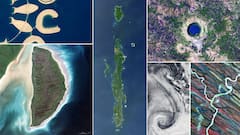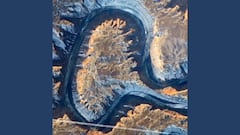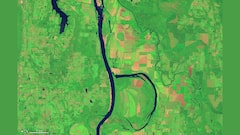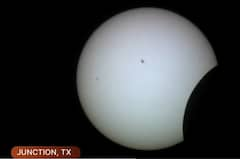Huge Meat-Eating Dinosaur Newly Identified From Egypt's Sahara Desert
The species has not yet been named. The fossil provides the first known record of the abelisaurid group of theropods from a middle Cretaceous-aged rock unit known as the Bahariya Formation.

A huge, meat-eating dinosaur has been newly identified from Egypt's Sahara Desert, an Egyptian-American team of researchers has announced. The dinosaur was a theropod, which was a group of dinosaurs characterised by hollow bones and three-toed limbs, and was discovered from a celebrated fossil site.
The species has not yet been named. The fossil provides the first known record of the abelisaurid group of theropods from a middle Cretaceous-aged rock unit known as the Bahariya Formation.
What Are Abelisaurids?
Abelisaurids are ceratosaurian theropod dinosaurs which thrived during the Cretaceous Period, on the ancient southern supercontinent of Gondwana, and were carnivorous bipeds, which means they travelled on two appendages. Ceratosaurs were the group of theropods which shared a more common ancestor with Ceratosaurus, a carnivorous theropod from the Late Jurassic Period, than with birds. Abelisaurids were most notably represented by the horned, demonic-looking Patagonian form Carnotaurus of Jurassic World and Prehistoric Planet fame. Patagonia is the southernmost region of South America, in Argentina and Chile, extending from the Andes to the Atlantic. Carnotaurus is a theropod dinosaur that lived in South America during the late Cretaceous Period, between 71 and 69 million years ago.
The Cretaceous Period began 145 million years ago and ended 66 million years ago. The Cretaceous Period was also the final time period of the Age of Dinosaurs.
The fossil remains of abelisaurids are found on the modern continents of Africa and South America, and also on the Indian subcontinent and the island of Madagascar.
Where Is The Bahariya Formation Located?
The Bahariya Formation, from which the fossil meat-eating dinosaur was discovered, is exposed in the Bahariya Oasis of the Western Desert of Egypt, and is approximately 98 million years old.
The study describing the Bahariya Formation dinosaur discovery was recently published in the journal Royal Society Open Science.
The Bahariya Formation yielded the original specimens of a host of remarkable dinosaurs in the early 20th century. These dinosaurs included the colossal sail-backed fish-eater Spinosaurus. The specimens were destroyed in the second World War. Fossils of abelisaurid dinosaurs had been discovered in Europe and in many of today's Southern Hemisphere continents, but never before from the Bahariya Formation.
The Fossil Is A Well-Preserved Vertebra From Base Of Neck Of Dinosaur
Led by researchers at Ohio University, the study described the fossil as a well-preserved vertebra from the base of the neck of a dinosaur, discovered as part of a 2016 Mansoura University Vertebrate Paleontology Center (MUV) expedition to the Bahariya Oasis. According to the study, the vertebra belongs to an abelisaurid, a kind of bulldog-faced, small-toothed, tiny-armed theropod dinosaur that is estimated to have been roughly six metres or 20 feet in body length. Abelisaurids were among the most diverse and geographically widespread large predatory dinosaurs in the southern landmasses during the Cretaceous Period.
Newly Identified Abelisaurid Roamed Earth 98 Million Years Ago
The study reports that the new abelisaurid fossil, along with Spinosaurus and two other giant theropods, Carcharodontosaurus and Bahariasaurus, adds yet another species to the cadre of large predatory dinosaurs that roamed the region of Earth which is now the Egyptian Sahara, 98 million years ago.
Bahariya Oasis Was One Of The Most Terrifying Places On Earth
In a statement released by Ohio University, Belal Salem, the lead author on the paper, said that during the mid-Cretaceous, the Bahariya Oasis would have been one of the most terrifying places on the planet. He added that how all these huge predators managed to coexist remains a mystery, though it is probably related to their having eaten different things, their having adapted to hunt different prey.
The study authors noted in the study that the new vertebra holds implications for the biodiversity of Cretaceous dinosaurs in Egypt and the entire northern region of Africa.
What Does The Bahariya Formation Fossil Reveal?
The Bahariya Formation fossil is the oldest known fossil of Abelisauridae from northeastern Africa, and shows that, during the mid-Cretaceous, these carnivorous dinosaurs ranged across much of the northern part of the continent, east to west from present day Egypt to Morocco, to as far south as Niger and potentially beyond. The fact that Spinosaurus and Carcharodontosaurus are also known from Niger and Morocco, and that a close relative of Bahariasaurus has been found in Morocco as well, suggests that this fauna of large to gigantic theropods coexisted throughout much of northern Africa at this time.
The Abelisaurid Fossil Is Virtually Similar To Carnotaurus, A Well-Known Abelisaur
A question arises that how can the discovery of a single neck vertebra lead researchers to conclude that the fossil belongs to a member of Abelisauridae, a kind of carnivorous dinosaur that has never been found in the Bahariya Formation before. According to the researchers, the answer is remarkably simple. The fossil is virtually identical to the same hone in other, better-known abelisaurids such as Carnotaurus from Argentina and Majungasaurus from Madagascar. Patrick O'Connor, a co-author on the paper, said he has examined abelisaur skeletons from Patagonia to Madagascar, and that his first glimpse of the specimen from photos left no doubt about its identity. He stated that abelisaurid neck bones are so distinctive.
What Is The Bahariya Oasis Famous For?
The Bahariya Oasis is famous within paleontological circles because it has yielded the type specimens of several extraordinary dinosaurs during the early 20th century, including Spinosaurus. Type specimens are the original, first-discovered, name-bearing fossils. However, all Bahariya dinosaur fossils which were collected before World War II were destroyed during an Allied bombing of Munich in 1944.
Matt Lamanna, another co-author on the paper, said the Bahariya Oasis has taken on near-legendary status among palaeontologists for having produced the first-known fossils of some of the world's most amazing dinosaurs. He had helped make the first dinosaur discoveries from the Bahariya Oasis since the infamous 1944 air raid.
Lamanna added that for more than three quarters of a century, these fossils have existed only as pictures in old books. Discoveries made during recent expeditions led by researchers from the American University in Cairo (AUC) and MUVP are helping to restore the palaeontological legacy of this classic site. The abelisaurid vertebra from Bahariya Formation is one such discovery. In the future, researchers plan to unveil a wealth of additional fossils recovered as part of these expeditions.
Will More Dinosaur Fossils Be Discovered?
Sanaa El-Sayed, one of the authors on the paper, explained that the bone is just the first of many important new dinosaur fossils from the Bahariya Oasis. El-Sayed had co-led the 2016 expedition that collected the abelisaurid vertebra.
According to Ohio University, the Bahariya Formation holds promise to shed further light on mid-Cretaceous African dinosaurs and the vanished ecosystems in which they once lived. The Bahariya Formation appears to preserve skeletons of dinosaurs and other land-animals with a relatively high degree of frequency. This is unlike more thoroughly explored rocks of the same age in Morocco that tend to yield isolated bones.
The study states that the more bones that are preserved within the skeleton of a given fossil backboned species, the more palaeontologists can generally learn about it. The tendency of the Bahariya Oasis for producing associated partial skeletons suggests that much remains to be learned from this historic locality.
Hesham Sallam, another co-author on the paper, said that in terms of Egyptian dinosaurs, the researchers have really just scratched the surface.
Trending News
Top Headlines








































